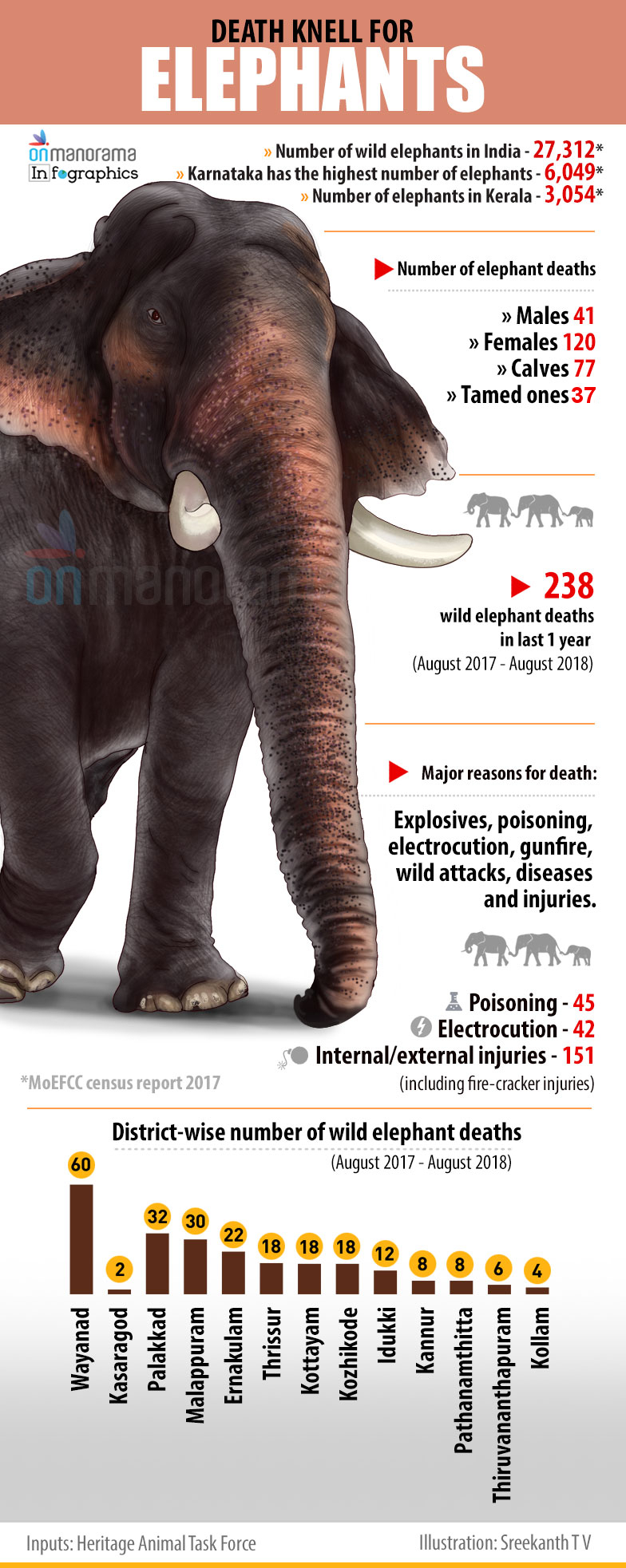Captive elephants on their last legs, deaths on the rise

Mail This Article
Thiruvananthapuram: This year is turning out to be the worst for young captive elephants in the state; 24 had died by the middle of September. In the last eight years, the highest number of elephant deaths was reported in 2011 and 2015: 32 deaths each. In all other years, it was less than 24.
The latest victim this year was 35-year-old Sevasangam Sreehari, which was found dead on September 16 in a private yard adjacent to Thuruthi LP School near Kuruppampady in Ernakulam. The elephant had a deep injury on the lower part of its front leg. The injury looked highly painful that the elephant balanced itself using its trunk during the last days of its life. After the elephant had ran amok last year during the 'vrischikolsavam' at the Thripunithura Poornathrayeesa Temple, it was tethered to a roof-less place on a private plot. It was exposed to the elements, and its wounds were left untreated.
The Baahubali fame
Some prominent captives are in serious condition. The most notable among them is Chirakkal Kalidasan, which was used by S S Rajamouli as the model for his 'motion capture' elephant in 'Baahubali II.' “Severe torture has left it virtually blind, and it has deep wounds behind its ears,” said V K Venkitachalam of Heritage Animal Task Force (HATF). The Forest Department has asked Kalidasan's custodians not to take it for festival processions and employ it for logging. Kalidasan, a majestic tusker with symmetrical features, is relatively older. The tusker is 42.
The elephants are dying mostly of overwork, torture, and inadequate care. The oldest tusker to die was Mangalamkunnu Guruvayurappan, and he was 38. It collapsed a day after it returned from a long and arduous festival season, and breathed its last the fourth day. The youngest to die this year was Neyyatinkara Kannan, and it had been chained to a tree for nearly three years near a temple on the outskirts of Thiruvananthapuram city. When it died two months ago, it looked so starved that the bones under its parched skin could be counted. Kannan was only 22.
The highest number of deaths, not surprisingly, was in Thrissur district: 10. Deaths in other districts: Thiruvananthapuram - one; Ernakulam and Palakkad - four each; Kottayam - three; and Kollam - two.
Wrong practices
Post-mortem conducted on all the dead elephants revealed that they had impaction, a severe form of constipation in which undigested food blocked the intestinal passage. Shivsundar's was perhaps the most mourned death in the state. Thousands paid homage to the tusker that belonged to the Thiruvambady temple in Thrissur, and was hailed as 'Azhakinte Thampuram' (The Lord of Good Looks). Shivsundar remained in a state of coma for over two months before it breathed its last.
Autopsy revealed massive constipated blocks, some as large as ration shop flour sacks, within the elephant's body.
The HATF's Venkitachalam said that rather than keeping them chained for the whole day, captive elephants should at least be allowed to walk freely for long hours in a sprawling fenced-in area. “You make them work so hard for your gains that the least that can be done is create such spaces for them. Walking is one way they can beat indigestion,” Venkitachalam said. It is Venkitachalam's figures on captive elephants that even the Forest Department relies on. According to him, 240 captive elephants have died in the state in the last 9 years. Now, only 384 captive elephants are left in the state.
Human limits
Dr Manilal of PETA (People for the Ethical Treatment of Animals) said the feed, the exercise, and the quantity of water these elephants require were so voluminous that it is beyond the capacity of a private individual to provide. “It is even unrealistic to ask them to grant such facilities to the elephants in their custody,” Dr Manilal said. The treatment of elephants, too, seem beyond the scope of humans. “Had it been cattle, we could have done enema or gastric intubation. But not on an elephant,” said Dr Gopikrishnan, a retired veterinarian. “Many veterinary surgeons have said that an elephant cannot be subjected to even surgery. The process is so complicated that the chances of secondary infections are very high,” Dr Gopikrishnan added.


